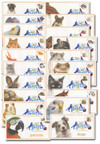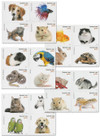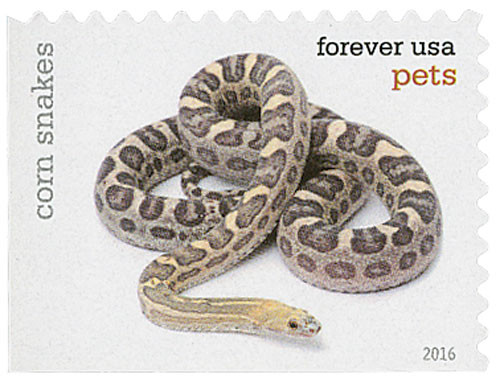
# 5106-25 - 2016 First-Class Forever Stamp - Pets
US #5106-25
2016 Pets
- Honors the wide range of animals we keep as pets
Stamp Category: Commemorative
Value: 47¢ First Class Mail Rate (Forever)
First Day of Issue: August 2, 2016
First Day City: Las Vegas, Nevada
Quantity Issued: 400,000,000
Printed by: Ashton Potter (USA) Ltd.
Printing Method: Offset
Format: Double-sided Booklet of 20
Tagging: Nonphosphored type III, block tag
Why the stamps were issued: To celebrate the many different animal companions we love and care for.
About the stamp designs: Each of the 20 designs pictures a photograph by Eric Isselée of a different domesticated animal: puppies, betta fish, iguanas, hamsters, goldfish, parrots, guinea pigs, tortoises, rabbits, kittens, corn snakes, mice, hermit crabs, chinchillas, gerbils, dogs, parakeets, horses, cats, and geckos.
First Day City: The First Day of Issue Ceremony was held at the SuperZoo National Show for Pet Retailers at the Mandalay Bay Resort in Las Vegas, Nevada.
History the stamp represents: Americans love their pets. In 2015 alone, over $60 billion was spent to purchase and care for them. In the United States, over 312 million dogs, cats, birds, horses, fish, reptiles, and other small animals are kept as pets and companions.
Many people adopt pets for companionship, but there are other benefits to owning an animal. Research has shown pets help lower blood pressure and lessen anxiety. Contrary to what many parents have believed, a growing number of studies suggest children growing up in a home with furred animals have less risk of developing allergies and asthma. The same studies have found these children also had stronger immune systems.
Alzheimer’s and dementia patients have fewer outbursts if there are pets in the home. Children with autism or learning disorders usually interact better with animals, and this behavior can serve as a bridge to connecting with humans. Dogs in particular are helpful in calming hyperactivity and aggression, as well as stimulating imagination.
Pet owners tend to suffer less from depression than those who do not own pets. Most owners find caring for a pet rewarding, which helps bring meaning and joy to life. By encouraging us to be playful, laugh, and exercise, pets help us increase our activity level and build stamina. One study found people with dogs walked 30 minutes more each week than they did previously, and lost weight without dieting. These activities benefit our pets as well by strengthening bonds, minimizing behavior problems, and keeping them fit and healthy.
US #5106-25
2016 Pets
- Honors the wide range of animals we keep as pets
Stamp Category: Commemorative
Value: 47¢ First Class Mail Rate (Forever)
First Day of Issue: August 2, 2016
First Day City: Las Vegas, Nevada
Quantity Issued: 400,000,000
Printed by: Ashton Potter (USA) Ltd.
Printing Method: Offset
Format: Double-sided Booklet of 20
Tagging: Nonphosphored type III, block tag
Why the stamps were issued: To celebrate the many different animal companions we love and care for.
About the stamp designs: Each of the 20 designs pictures a photograph by Eric Isselée of a different domesticated animal: puppies, betta fish, iguanas, hamsters, goldfish, parrots, guinea pigs, tortoises, rabbits, kittens, corn snakes, mice, hermit crabs, chinchillas, gerbils, dogs, parakeets, horses, cats, and geckos.
First Day City: The First Day of Issue Ceremony was held at the SuperZoo National Show for Pet Retailers at the Mandalay Bay Resort in Las Vegas, Nevada.
History the stamp represents: Americans love their pets. In 2015 alone, over $60 billion was spent to purchase and care for them. In the United States, over 312 million dogs, cats, birds, horses, fish, reptiles, and other small animals are kept as pets and companions.
Many people adopt pets for companionship, but there are other benefits to owning an animal. Research has shown pets help lower blood pressure and lessen anxiety. Contrary to what many parents have believed, a growing number of studies suggest children growing up in a home with furred animals have less risk of developing allergies and asthma. The same studies have found these children also had stronger immune systems.
Alzheimer’s and dementia patients have fewer outbursts if there are pets in the home. Children with autism or learning disorders usually interact better with animals, and this behavior can serve as a bridge to connecting with humans. Dogs in particular are helpful in calming hyperactivity and aggression, as well as stimulating imagination.
Pet owners tend to suffer less from depression than those who do not own pets. Most owners find caring for a pet rewarding, which helps bring meaning and joy to life. By encouraging us to be playful, laugh, and exercise, pets help us increase our activity level and build stamina. One study found people with dogs walked 30 minutes more each week than they did previously, and lost weight without dieting. These activities benefit our pets as well by strengthening bonds, minimizing behavior problems, and keeping them fit and healthy.




















